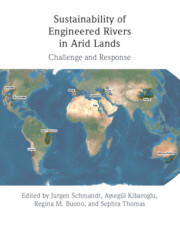Book contents
- Sustainability of Engineered Rivers in Arid Lands
- Sustainability of Engineered Rivers in Arid Lands
- Copyright page
- Dedication
- Contents
- Contributors
- Part I Introduction
- Part II Challenge
- Part III Engineered Rivers
- 7 The Nile River Basin
- 8 The Euphrates–Tigris River Basin
- 9 The Yellow River Basin
- 10 The Murray–Darling River Basin
- 11 The São Francisco River Basin
- 12 The Limarí River Basin
- 13 The Colorado River Basin
- 14 The Rio Grande / Río Bravo Basin
- 15 The Jucar River Basin
- Part IV Response
- Part V Conclusion
- Index
- References
10 - The Murray–Darling River Basin
from Part III - Engineered Rivers
Published online by Cambridge University Press: 16 September 2021
- Sustainability of Engineered Rivers in Arid Lands
- Sustainability of Engineered Rivers in Arid Lands
- Copyright page
- Dedication
- Contents
- Contributors
- Part I Introduction
- Part II Challenge
- Part III Engineered Rivers
- 7 The Nile River Basin
- 8 The Euphrates–Tigris River Basin
- 9 The Yellow River Basin
- 10 The Murray–Darling River Basin
- 11 The São Francisco River Basin
- 12 The Limarí River Basin
- 13 The Colorado River Basin
- 14 The Rio Grande / Río Bravo Basin
- 15 The Jucar River Basin
- Part IV Response
- Part V Conclusion
- Index
- References
Summary
This chapter analyzes sustainable river management in the Murray–Darling Basin, where growing salinity problems and decreasing security of supply began to cause political conflict between and within the four states that share the catchment. The Murray–Darling Basin Authority has been responsible for coordinating the management of storage reservoirs, major infrastructure, and cross-border flows since 1917. In recent years, however, water needs of different activities are mediated through the dynamics of the market rather than the decisions of government officials. In many regions in the basin, however, water management is more complex now than it was only a few decades ago. The shortage of skilled personnel to manage Australia’s highly modified hydrological systems, which is already making itself felt, could well prove the greatest risk in the medium and longer term.
Keywords
- Type
- Chapter
- Information
- Sustainability of Engineered Rivers In Arid LandsChallenge and Response, pp. 121 - 131Publisher: Cambridge University PressPrint publication year: 2021



